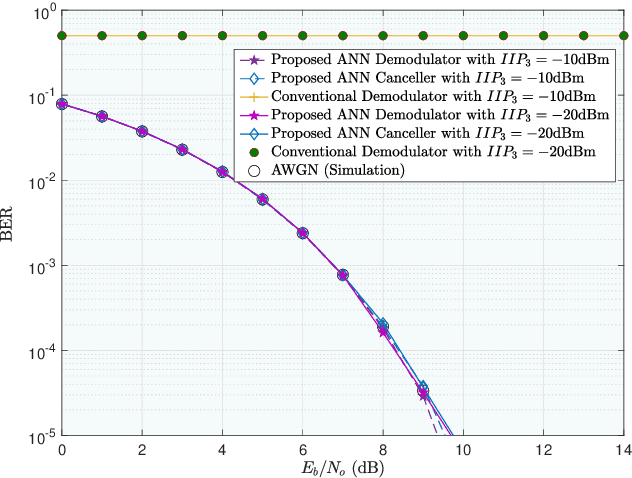Talha Faizur Rahman
AI-Driven Demodulators for Nonlinear Receivers in Shared Spectrum with High-Power Blockers
Jan 24, 2022



Abstract:Research has shown that communications systems and receivers suffer from high power adjacent channel signals, called blockers, that drive the radio frequency (RF) front end into nonlinear operation. Since simple systems, such as the Internet of Things (IoT), will coexist with sophisticated communications transceivers, radars and other spectrum consumers, these need to be protected employing a simple, yet adaptive solution to RF nonlinearity. This paper therefore proposes a flexible data driven approach that uses a simple artificial neural network (ANN) to aid in the removal of the third order intermodulation distortion (IMD) as part of the demodulation process. We introduce and numerically evaluate two artificial intelligence (AI)-enhanced receivers-ANN as the IMD canceler and ANN as the demodulator. Our results show that a simple ANN structure can significantly improve the bit error rate (BER) performance of nonlinear receivers with strong blockers and that the ANN architecture and configuration depends mainly on the RF front end characteristics, such as the third order intercept point (IP3). We therefore recommend that receivers have hardware tags and ways to monitor those over time so that the AI and software radio processing stack can be effectively customized and automatically updated to deal with changing operating conditions.
Handover Experiments with UAVs: Software Radio Tools and Experimental Research Platform
Jan 03, 2022



Abstract:Mobility management is the key feature of cellular networks. When integrating unmanned aerial vehicles (UAVs) into cellular networks, their cell association needs to be carefully managed for coexistence with other cellular users. UAVs move in three dimensions and may traverse several cells on their flight path, and so may be subject to several handovers. In order to enable research on mobility management with UAV users, this paper describes the design, implementation, and testing methodology for handover experiments with aerial users. We leverage software-defined radios (SDRs) and implement a series of tools for preparing the experiment in the laboratory and for taking it outdoors for field testing. We use solely commercial off-the-shelf hardware, open-source software, and an experimental license to enable reproducible and scalable experiments. Our initial outdoor results with two SDR base stations connected to an open-source software core network, implementing the 4G long-term evolution protocol, and one low altitude UAV user equipment demonstrate the handover process.
 Add to Chrome
Add to Chrome Add to Firefox
Add to Firefox Add to Edge
Add to Edge